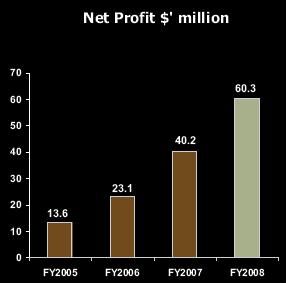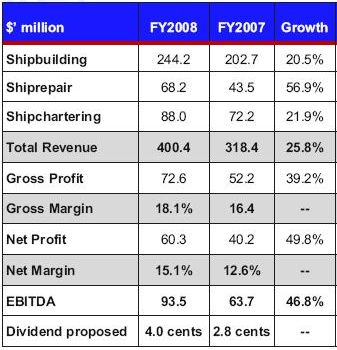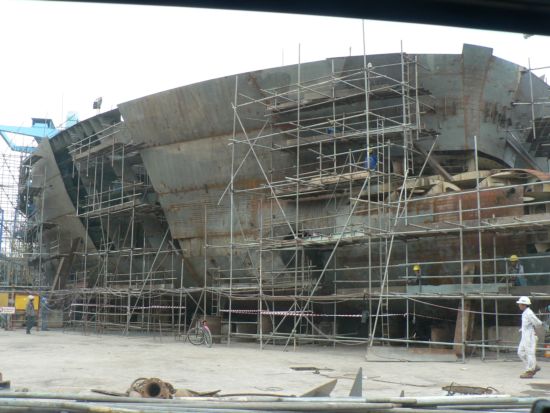 At ASL Marine, this was a rare first-hand opportunity to view a ship resting on dry ground in a dock where the sea water had been pumped out. Photo by Leong Chan Teik
At ASL Marine, this was a rare first-hand opportunity to view a ship resting on dry ground in a dock where the sea water had been pumped out. Photo by Leong Chan Teik

THIS SHIP was among four seen on Tuesday (Oct 7) sitting pretty at the drydock of ASL Marine in Batam, undergoing maintenance and repairs.
They had sailed in, and then the gates (in the background of the picture) were lifted and the sea water pumped out from the drydock.
Work on ships may go on around the clock, and it’s not a rare sight for hundreds of workers to be busy in the dead of the night, as we were told during a visit organized for eight Singapore analysts to the yard. Nearly 3,000 workers – mostly Indonesians - are employed there.
Ship repair and maintenance, which has increased during the shipping boom of the recent years, continues to be in strong demand, said ASL Marine managing director Ang Kok Tian.
“The volume of enquiries is strong. The shipbuilding boom will contribute to a ship repair boom.”
Simply put, with many more ships out at sea, more repair and maintenance services will be needed. Shiprepair and maintenance is a far less cyclical business than shipbuilding, explained Mr Ang.
He said his company is taking steps to expand its capacity for this business segment, which will lead to bigger ships being serviced – beyond the Alfamax tankers and including specialized vessels and over 90% of the types of the world’s cargo vessels.
ASL will lengthen its existing 150,000 dwt drydock from 260 metres to approx 360 metres for repairing larger vessels such as Capesize bulker and FSO/FPSO.
 ASL Marine official briefing analysts at the site of the dry dock.
ASL Marine official briefing analysts at the site of the dry dock.
It will also add two new graving drydocks of 220 metres and 180 metres for repairing medium-sized vessels such as Panamax, Handy/ Handymax, and medium-range tankers by next year.
The total investment for the lengthening of the drydock and the building of two new drydocks is approximately $30 million.
It would be funded through a combination of internal resources and borrowings from the issuance of floating rate notes in June 2008.
What if the current financial turmoil leads to ships being taken out of service? Mr Ang said that such a development would also spell business opportunities further down the road.
“Reactivating a vessel can be big business for us. It can cost a few million dollars, depending on the type of ship and the type of reactivation work.”
 Sharp jump in ship repair revenue, which commands the highest gross margin.
Sharp jump in ship repair revenue, which commands the highest gross margin.
Ship repair and maintenance command a higher profit margin - of 31.1%, or about thrice as much as for shipbuilding while shipchartering's stood at 29.9% - than shipbuilding.
But given its ad hoc nature, you don’t know how much ship repair work will be forthcoming beyond the next few months. (As an analogy, a car workshop wouldn’t know how many motorists will send their cars in beyond the next few days)
Shipbuilding, in contrast, is a long-term commitment – and ASL has a record shipbuilding orderbook of $693 million (as of end-June) for external customers.
ASL has said that approximately 48% of that order book is expected to be recognised in the current financial year ending 30 June 2009.
Subsequently, on Oct 6, ASL announced that it had secured new shipbuilding and fabrication contracts worth a total of $101 million.
For the year ended June 2008, ASL reported a 49.8% jump in net profit to $60.3 million. Revenue rose 25.8% to $400.4 million.
Basic earnings per share was 21.09 cents, which means the stock at a recent price of 66 cents was trading at 3.1X PE. It was also trading at below net asset value (as at end-June 2008) of 78.60 cents.
ASL is currently trading cum dividend of 4 cents a share.
On its expected performance in FY09, ASL has said in a statement: “Based on the Group’s shipbuilding outstanding order book, enhanced ship repair capabilities and enlarged fleet size for ship chartering operations, barring any unforeseen circumstances, the Group is cautiously optimistic of achieving higher revenue and earnings in FY2009 amidst the current economic environment and rising operating costs.”
 After the steel parts of a ship are fabricated, they are assembled and fittings such as pipes and electrical wiring are installed.
After the steel parts of a ship are fabricated, they are assembled and fittings such as pipes and electrical wiring are installed.
 Workers at ASL Marine start and end their work by registering their fingerprint at the gates.
Workers at ASL Marine start and end their work by registering their fingerprint at the gates.
After the trip, Rohan Suppiah, an analyst with Kim Eng Securities, wrote: “We like ASL’s prospects across all its 3 primary business divisions. For shipchartering, ASL is expanding its fleet by 15 vessels over the next 3 years. For shipbuilding, it specialises in higher value added jobs. ASL recently announced S$101 million in contracts….
”We maintain FY09 profit forecast of S$69.0 million, but are adjusting our target price to S$1.62 based on 7x FY09 earnings, in line with the STI Index valuation to reflect broader market weakness. This still implies 120% upside for an undervalued stock, trading at just 3.2x (based on 74 cents).”
Our visit to Marco Polo Marine shipyard in Batam: MARCO POLO: From newbuilding to shiprepair





